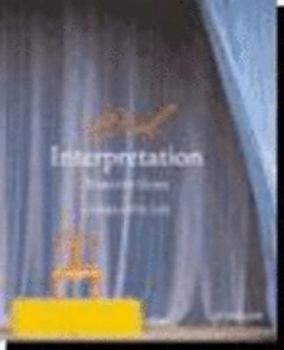Oral Interpretation
Select Format
Select Condition 
Book Overview
In its 13th Edition, the iconic Oral Interpretation continues to prepare students to analyze and perform literature through an accessible, step-by-step process. New selections join classic favorites,... This description may be from another edition of this product.
Format:Paperback
Language:English
ISBN:0618308172
ISBN13:9780618308170
Release Date:June 2004
Publisher:Routledge
Length:528 Pages
Weight:1.95 lbs.
Customer Reviews
1 rating
Learning the fine art of reading aloud to others
Published by Thriftbooks.com User , 21 years ago
"Oral Interpretation" was a standard textbook for so long because it does a superb job of combining theory and practice. Authors Charlotte I. Lee and Timothy Gura begin by talking about the importance of choosing a selection for oral interpretation by basing your selection on the key touchstones of universality, individuality, and suggestion. At the heart of this approach is the advice actor Spencer Tracy always gave to his colleagues, which was "to know your lines." Of course, there are layers of meaning to Tracy's simple dictum, and it is uncovering all those layers that Lee and Gura try to impress upon their students.In addition to choosing a selection, the Basic Principles section of the textbook deals with Analyzing the Selection, Voice Development for Oral Interpretation, and The Use of the Body in Oral Intepretation. Consequently, the mind which analyses the selection is as crucial as the voice and body that interpret it for the listening audience. You will be impressed with the vareity of selections that are includes for analysis and oral interpretation. For example, in the Voice Development chapter you have selections as diverse as Garrison Keillor's "Lake Wobegon Days," Lewis Carroll's "Jabberwocky," Mathew Arnold's "Dover Beach," and a Navajo Ceremonial Chant. "Oral Interpretation" then looks in turn as the major genres of writing that can be interpreted: Prose, Drama, and Poetry. There is also a chapter devoted to Group Performance, which tends to cut across the other three areas. The approach of Lee and Gura is to break down each form into specific elements that can be addressed in interpreting the text. This means speech phrases, balancing sentences, and tone color for prose; scenography, embodying characters, and physical focus for drama; and allusions, figures of speech, and sensory appeals for poetry. There are also appendixes offering Some Notes on Directing the Group Performance, Building and Presenting a Program, and a Brief History of Theories of Interpretation. The goal, as with the main part of the textbook, is to prepare teachers and students of oral interpretation for all eventualities."Oral Interpretation" was the textbook I used when teaching this particular class because of its comprehensiveness and its emphasis on practical advise. For me the key part was always the critical understanding of the selection, taking the piece apart so that you understood how it worked and could put it back together in performance and breath life into the words. Students always appreciated the specificity of the examples, where a paragraph could be devoted to taking apart a single sentence or appreciating the particular combinations of vowels and consonants that appear in a particular line of rhyme. Even those students who feel that they their voices are unsuited to oral intepretation, can appreciate the critical approach to understanding literature that they learn from this volume.




